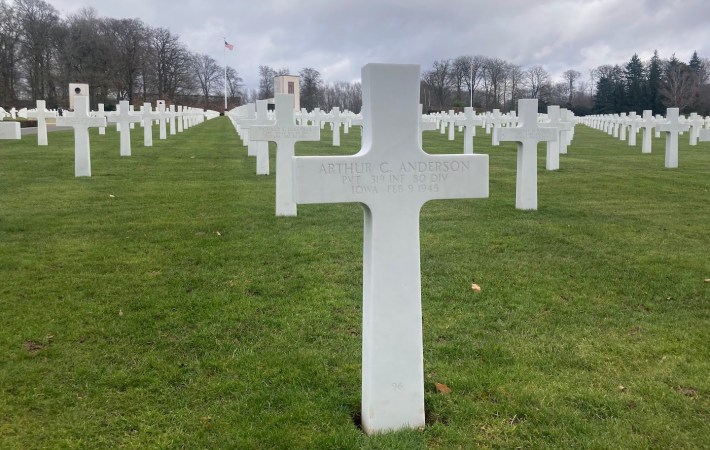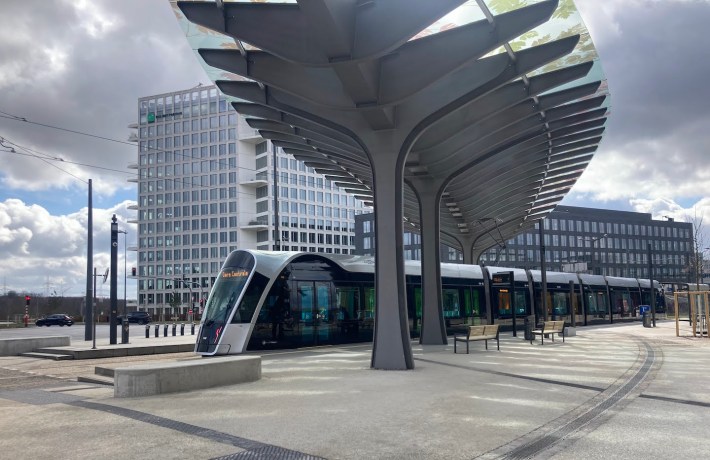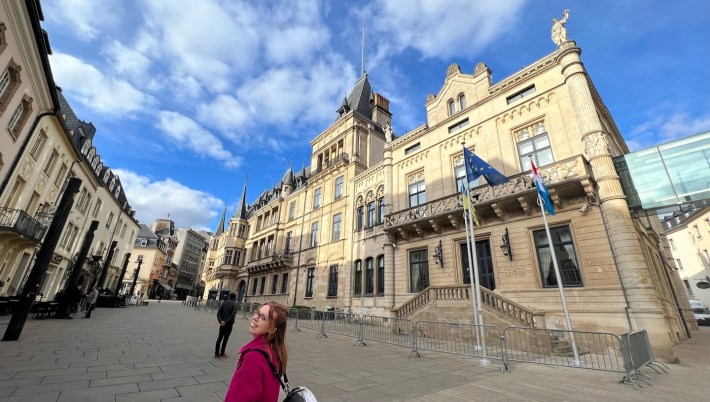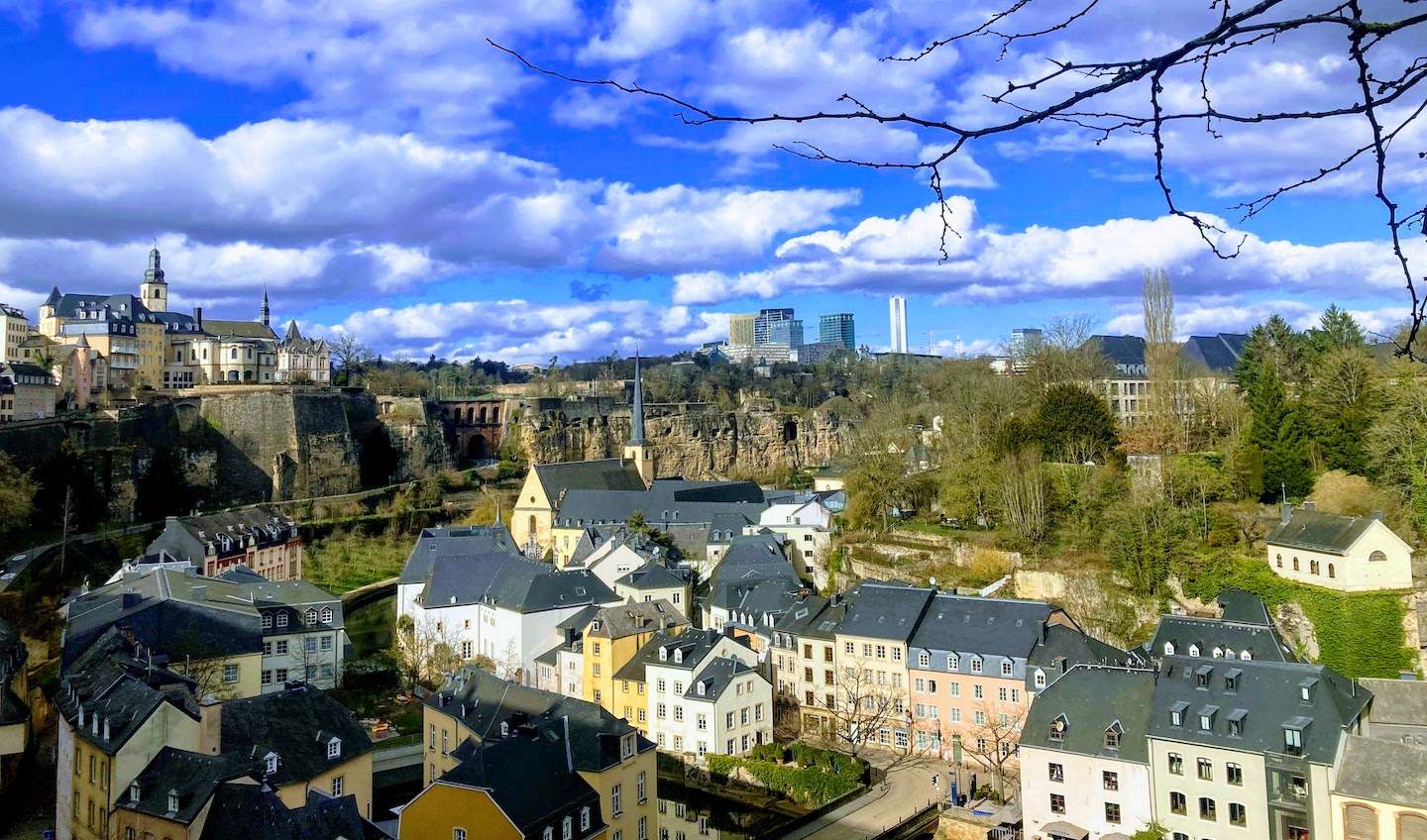I don’t think I had ever given any thought to Luxembourg until a few years ago, on the 75th anniversary of D-Day, I was overcome with curiosity about what happened to my grandpa’s uncle, who I knew had died in World War II. So I called him to ask, and he told me Uncle Art had died in the Battle of the Bulge. He left behind his wife, Hazel, in Boone, Iowa. They didn’t have any kids, but he’d been a successful salesman for a casket company. So where is he buried? I asked my grandpa. Did they send him back here?
No, he was buried somewhere in Europe.
Somewhere in Europe?! Where? He didn’t know or couldn’t remember.
So I got on my laptop and within 10 minutes of searching, I had pulled up a photo of Uncle Art’s grave, at the Luxembourg American Cemetery and Memorial, just outside of Luxembourg City. I sent my grandpa the information and asked him if anyone in the family had ever gone to visit. He wasn’t sure and thought maybe his aunts had gone at some point. I felt sad thinking about Uncle Art resting so far from Iowa without anyone visiting him, so I made a pact with myself that the next time I traveled to Europe, I’d make a pit stop in Luxembourg.
Luxembourg is the smallest country in the world that is not an island or considered a microstate. It seemed like a place I would probably never end up in for any other reason, and it would be fun to add it to my list of countries. It’s nestled among Belgium, France, and Germany, so when I planned a trip to Paris, I knew I would have to make a day trip to Luxembourg, which is just a two-hour high-speed train ride away. I tried to do some research on what there is to do in Luxembourg, but a cursory online search turned up an answer of: not much. Rick Steves had nothing on it, except one post on a forum wondering why Rick hadn’t bothered to do a Luxembourg guide.
We hopped on the train from Paris and took a nice scenic ride through the French countryside. That morning, I’d woken up in a panic thinking we might need our passports. (I will admit that I had been roasted in Defector Slack a few weeks earlier for dismissing the importance of the Schengen Area. Now I get it.) No one even checked our train tickets on the way. We got off at picturesque old Gare Lëtzebuerg, and hopped into a cab to the cemetery, about a 10-minute drive.
We stepped out of the cab and saw no one else was there. The sky was gray and it was completely silent. There was only one car in the big parking lot. Are they open? I panicked again. The big gate at the front opened, but we were the only visitors I could see. We popped inside the welcome building, where a sign on an office door said that the caretaker was on the grounds but would be back shortly.
After a few minutes, the caretaker returned. His name was Chris and he looked up Uncle Art in the system to see if he had any extra notes or research on him, because he spends a lot of his time doing research on the soldiers buried at the cemetery. He didn’t find anything except the basic form and the location of his grave, and he directed us toward it. Chris told us he'd served in the Navy and then worked at several American cemeteries in Europe. He explained to us that there are 5,070 American soldiers buried there, most of them casualties from the Battle of the Bulge. The white marble graves are laid out in a semi-circle fanning from the main memorial chapel, with General George Patton’s grave at the front.
How many visitors do you get here? I asked, looking around at the empty lawn. “Not many since COVID,” Chris said. “But we do get a lot of Chinese tour groups.”
“Why is that?” I asked.
“Karl Marx was born in a nearby town in Germany, so they go to visit his birthplace, and then they come here to see Patton’s grave. I asked one man why he liked Patton so much and he said it’s because the Chinese view Patton as a warrior, and they're very glad he died before the Korean War.”
Chris said he still gets some veterans that come by who served in the Third Army under Patton, and they all complain about how much they hated his guts.
We walked all the way to the back of the cemetery lawn, Plot H, Row 15, Grave 96. There he was! Arthur C. Anderson, Iowa. Feb. 9, 1945. I noticed that The Battle of the Bulge officially ended about two weeks before Uncle Art died. I'm not sure what the full story is, but this record of deaths in the 80th division confirms he was KIA on Feb. 9. Another record says that on Feb. 7, 1945, the 319th infantry first entered Germany from Luxembourg and captured the town of Wallendorf. On Feb. 12, the 319th captured their second German town, Ammeldingen, so Uncle Art didn't die during the actual Battle of the Bulge, but sometime in between capturing German towns. This document describes the battles on Feb. 9 when the 319th infantry met "heavy resistance" and "heavy enemy artillery fire" from Germans in pillboxes as they attempted to move north from Wallendorf. Here's a cool map of the path the 319th infantry took through France, Luxembourg, Germany, and Austria.

We walked back up the memorial center of the cemetery, where there were big confusing maps of the Allied vs. Axis movement during the war. We read the guest book inside the small chapel. Every other entry included an anti-war message. “Stop war!” “Stop a guerra!” “Fuck Putina!”
We then asked Chris, who had been a great guide, what we should do with the rest of our day in Luxembourg. He shrugged. He'd only lived there a year or two, and said, “I don’t know, maybe buy some whiskey? It’s really cheap here. Or go back to Paris? Or if you have a car, drive 20 minutes to Germany to hit another country. When’s your train?”
We had about five hours to entertain ourselves until our train back. So we hopped into the free shuttle back to the city. Our driver was a young redheaded guy who looked nice and approachable. We were obviously the only people on board, so I decided to ask him for his recommendations, specifically where to find some good food. We were starving. He also shrugged and took out his phone, searching for a restaurant that he couldn’t remember the name of. A few minutes of silence passed as he searched and searched. “I can’t find it,” he said. “It might be closed now.”
As the driver pulled out of the cemetery lot and started taking us back down the hillside, I peppered him with questions about life in Luxembourg. His name is Tun (a traditional Luxembourgish name) and he plays soccer for Canach, a local football club. They apparently aren't doing so hot and are trying not to get relegated. Tun was born and raised there and has never lived anywhere else. He speaks English, French, German, and Luxembourgish, which is sort of a combination of French and German. He spoke some Luxembourgish for us and it sounded so different from either. That night, he said, he was going to have to play keeper, which is not his position, for Canach’s second team, because they didn’t have one. We wished him luck as he dropped us off at the tram station that would take us into the downtown.

We still had no idea what we were going to do with our day, since so far, no one we’d talked to in Luxembourg had any ideas whatsoever. But to be honest, the tram was a real highlight. All public transportation is free here, and it’s so clean, and there’s wifi and usb chargers at every seat! I had never experienced anything like it and we contemplated just riding the tram for the next few hours. But we did not.
Because it was Monday, a lot of the restaurants were closed or closing early, so we settled on a burger place. Lux Burgers had themed burgers named after all the neighboring countries and regions. I got the Henri burger which included Luxembourgish ham. The owner didn’t speak much English so we couldn’t ask him what else we should do that day. But while we were eating, a group of four guys who looked about our age sat down at the table next to us. They spoke in English, and I thought OK, maybe these guys can tell us what to do next.
I introduced myself and they said they were all scientists at the natural history museum. “You should go there!” one of them said. “It’s closed today,” said another. “Oh yeah, right” said the first one.
“There’s not much to do here, especially on a Monday,” he added. I know.
These cute scientists seemed fully out of ideas after that, and instead asked us about our train ride, and told us that no, the train workers never check your ticket. This was good; that morning, I read my ticket closer and realized I had bought the wrong return date. Instead of getting a ticket back that night, I’d actually bought one for the following morning. Damn European backwards dates and 24-hour time! I'd been able to exchange it, but imagine having to kill a whole night here.
What about chocolate? I asked. I'd read somewhere that there was good chocolate to be had in Luxembourg. “Oh yeah, there’s the Chocolate House,” the second one said. After a brief struggle to locate it on Google Maps, he told us that the palace was right across the street from there, so we could check that out too. Oooo, the palace! Now we were finally getting somewhere.
We finished up lunch and the sweet scientists pointed us in the right direction. They had to run because they needed to buy materials to set up “hair traps” to collect hair from local wildlife like rabbits and mice in order to identify them so they could then petition the government to better protect the species native to Luxembourg. Adorable! I told second scientist that I was a journalist, and he asked me if I ever write about science. No, not really, I said. “You should! Write about us! Write about Luxembourg!”
“We’ll see,” I said.
We set off and crossed a big scenic bridge to find a beautiful foresty path. We skipped and danced along, because the sun had just come out and we had the path all to ourselves. We wound around a high, craggy bank of the Petrusse, and ended up at the top of the city near a beautiful church built in 1621. There was a lively skate scene happening out front, with loud music and amateur videographers. We weaved through the skaters to get to the church doors to check it out. My friend bought a rosary for her grandma, who has Luxembourgish ancestry, and we even got it blessed by the priest, who was sitting in the confessional downstairs. He took out his phone to look up the correct blessing. Hardly anyone else was inside the church; I probably didn't need to tell you that by now.

Then we kept walking to the chocolate house, which was just feet away from the Palais Grand-Ducal. The streets were so clean and empty and the Palace looked fake, like it was too pretty and perfect to be real. It didn’t seem lived-in at all and the whole area reminded me of Duloc in Shrek. Out front, a line of four soldiers completed a changing of the guard, stomping their boots and staring straight ahead, ignoring my waving and cooing.
We bought flavored hot chocolates and sat down in front of the palace in the fading afternoon sunlight. Then we walked back to our beloved tram and rode back down to the train station, where we bought mini-bottles of champagne for the ride. We cheersed to a day well spent. We were back in Paris in time for our 10 p.m. dinner reservation in Montmartre.
We’d exchanged Instagrams with Tun, and the next day, Tun messaged me the sweetest thing I have ever read.
“So I just wanna thank you for yesterday… it was nice to speak with someone cause normally there is no one the hole [sic] day in my shuttle… Hope you and your girls enjoyed your little trip to luxembourg.”
Now that you have finished this Luxemblog, and despite what the locals say, I will recommend that you go visit Luxembourg, if only so Tun has someone to talk to.






